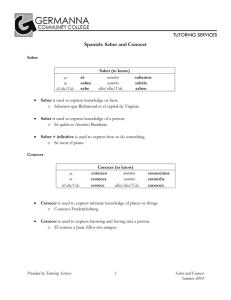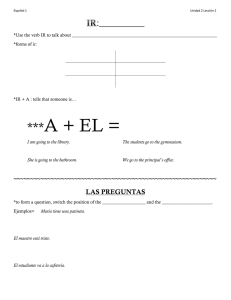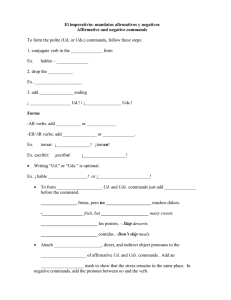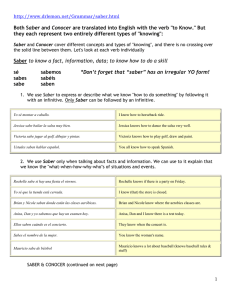4 year: As a review, please study the next few pages before you do
Anuncio
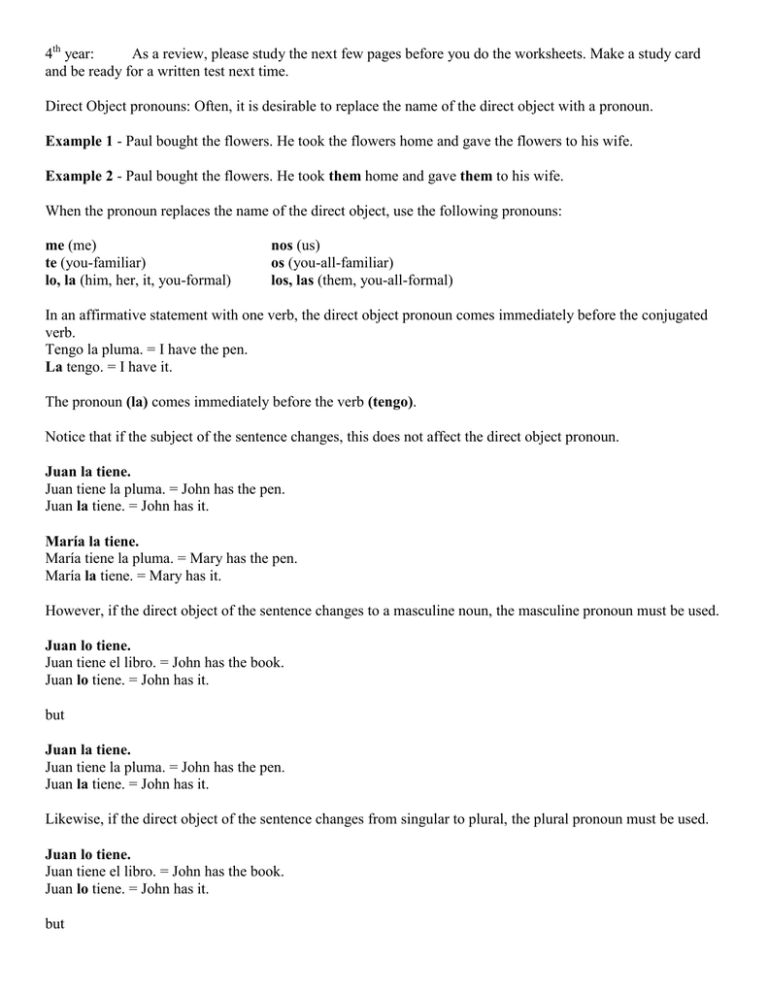
4th year: As a review, please study the next few pages before you do the worksheets. Make a study card and be ready for a written test next time. Direct Object pronouns: Often, it is desirable to replace the name of the direct object with a pronoun. Example 1 - Paul bought the flowers. He took the flowers home and gave the flowers to his wife. Example 2 - Paul bought the flowers. He took them home and gave them to his wife. When the pronoun replaces the name of the direct object, use the following pronouns: me (me) te (you-familiar) lo, la (him, her, it, you-formal) nos (us) os (you-all-familiar) los, las (them, you-all-formal) In an affirmative statement with one verb, the direct object pronoun comes immediately before the conjugated verb. Tengo la pluma. = I have the pen. La tengo. = I have it. The pronoun (la) comes immediately before the verb (tengo). Notice that if the subject of the sentence changes, this does not affect the direct object pronoun. Juan la tiene. Juan tiene la pluma. = John has the pen. Juan la tiene. = John has it. María la tiene. María tiene la pluma. = Mary has the pen. María la tiene. = Mary has it. However, if the direct object of the sentence changes to a masculine noun, the masculine pronoun must be used. Juan lo tiene. Juan tiene el libro. = John has the book. Juan lo tiene. = John has it. but Juan la tiene. Juan tiene la pluma. = John has the pen. Juan la tiene. = John has it. Likewise, if the direct object of the sentence changes from singular to plural, the plural pronoun must be used. Juan lo tiene. Juan tiene el libro. = John has the book. Juan lo tiene. = John has it. but María los tiene. María tiene los libros. = Mary has the books. María los tiene. = Mary has them. Differences: 1. "It" has two forms in Spanish: lo, la 2. "Tengo" one word in Spanish = two words in English (I have) 3. The word order is different. In Spanish, the pronoun (lo, la) comes before the verb; in English, the pronoun (it) comes after the verb. The personal “a” In Spanish, when the direct object is a person, it is preceded by the preposition "a." This word has no English translation. Jorge llama a María. Jorge calls María. From the perspective of the English speaker, the personal "a" appears to be an extra word. From the perspective of the Spanish speaker, the personal "a" is required, and to not use it is a serious error. Jorge llama a María. The personal "a" may also be used if the direct object is a domesticated animal, especially a pet, provided that the speaker attaches some sort of personal feelings towards the animal. La mujer acaricia a su perro. (acariciar) The woman pets her dog. El perro persigue a la gata. (perseguir) The dog chases the cat. The personal "a" is not used when the direct object is not a person or is an animal for which no personal feelings are felt. Bebo la leche. (beber) I drink the milk. -- milk is neither a person nor an animal Miro la jirafa. (mirar) I look at the giraffe. -- no personal feelings are felt towards the giraffe The personal "a" is not used after the verb tener, or the verb form hay. This is true even if the direct object is a person. Tengo dos hermanos. (tener) I have two brothers. Hay cinco chicas. There are five girls. If the direct object is an indefinite person, the personal "a" is not used. The result is that the person becomes "depersonalized." Necesito médico. I need (any) doctor. (or) I need medical assistance. Necesito jardinero. I need (any) gardener. (or) I need someone to tend my garden. Saber/conocer In Spanish, there are two verbs that express the idea "to know." These two verbs are "saber" and "conocer." The verb you choose depends upon the context in which it is used. These verbs are not interchangeable. To express knowledge or ignorance of a fact or information about something, use "saber." Juan sabe donde está María. Juan knows where Maria is. Yo no sé tu número de teléfono. I don't know your telephone number. To say that one is or is not acquainted with a person, a place, or an object, use conocer. Yo no conozco a María. I don't know (am not acquainted with) Maria. Alberto y Alfredo conocen Madrid. Alberto and Alfredo know (are acquainted with) Madrid. To express knowledge or ignorance of a subject or learning discipline, use saber or conocer, depending upon the context. Juan no sabe nada de inglés. Juan doesn't know any English. Él sabe matemáticas. He knows mathematics. Juan conoce la literatura española. Juan is familiar with Spanish literature. To express knowledge or ignorance of a skill, or how to do something, use saber + infinitive. María sabe conducir. Maria knows how to drive. No sé nadar muy bien. I don't know how to swim very well. To say that you know something by heart, use saber. María sabe los verbos irregulares. Maria knows the irregular verbs (by heart). Ella no sabe la letra de esa canción. She doesn't know the words to that song. The situation with regards to the correct use of saber and conocer can be summarized as follows: saber to know a fact, to know something thoroughly, to know how to do something conocer to be acquainted with a person, place, or thing The same sort of situation exists with respect to the two Spanish verbs pedir and preguntar. They both mean "to ask" but they are not interchangeable. Fortunately, the rules for using them are a bit more straightforward: pedir to ask for, or request an object, service or favor Pido más carne. I ask for more meat. Pedimos ahora. We order now (ask for service). preguntar to ask a question, or request information Pregunto qué hora es. I ask what time it is. Preguntamos a qué hora sirven la cena. We ask what time they serve dinner. Formal Commands Commands are used when ordering, or telling someone to do something. This is often referred to as the "imperative" form of the verb. Compre Ud. el anillo. (You) Buy the ring. Haga Ud. la tarea. (You) Do the homework. Compren Uds. los libros. (You-all) Buy the books. Hagan Uds. el trabajo. (You-all) Do the work. Informal, or familiar, speech is used among friends, coworkers, relatives, or when addressing a child. Formal speech is generally used to be polite or to express respect. For that reason, the formal commands are often referred to as polite commands. The formal commands are formed the same way as the present subjunctive: 1. Start with the yo form of the present indicative. 2. Then drop the -o ending. 3. Finally, add the following endings: -ar verbs: -e (for Ud.), -en (for Uds.) -er and -ir verbs: -a (for Ud.), -an (for Uds.) Remember, if the first person singular (yo) form is irregular, that irregularity is carried over into the formation of the formal command. Tengan Uds. un buen viaje. (yo tengo) Have a good trip. Traiga Ud. el dinero. (yo traigo) Bring the money. Venga Ud. conmigo. (yo vengo) Come with me. This also applies to stem-changing verbs. Cuente Ud. sus beneficios. (yo cuento) Count your blessings. Vuelvan Uds. pronto. (yo vuelvo) Return quickly. Pida dinero. (yo pido) Ask for money. As with the present subjunctive, the following verbs are irregular: dar dé Ud. den Uds. ser sea Ud. sean Uds. estar esté Ud. estén Uds. saber sepa Ud. sepan Uds. ir vaya Ud. vayan Uds. Note that affirmative and negative commands use the same verb forms. Hable Ud. Speak. No hable Ud. Don't speak. Coma Ud. Eat. No coma Ud. Don't eat. Escriba Ud. Write. No escriba Ud. Don't write. Also note that the subject pronouns Ud. and Uds. may or may not be used. Using them adds a degree of formality or politeness to the command. Hable. Speak. Hable Ud. Speak (sir). (more respectful) Coma. Eat. Coma Ud. Eat (sir). (more polite) Irregular Formal Commands (Imperative) Same irregulars as the present subjunctive forms dar dé Ud. den Uds. ser sea Ud. sean Uds. estar esté Ud. estén Uds. saber sepa Ud. sepan Uds. ir vaya Ud. vayan Uds. Make a study card for the test that will be next time: Study Ch. 7 pages 198-229 - All vocabulary and especially pgs. 200, 201, 203, 206, 207, 208, 211, 212, 213, 216, 217, 228, 229.
